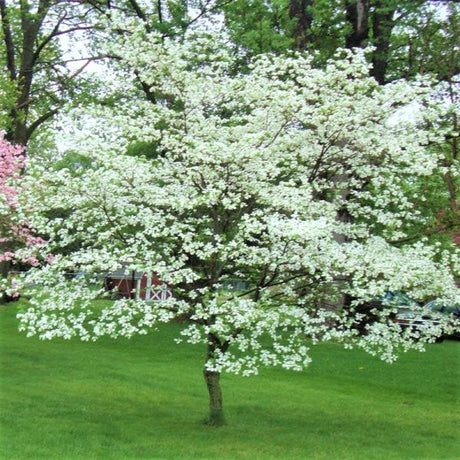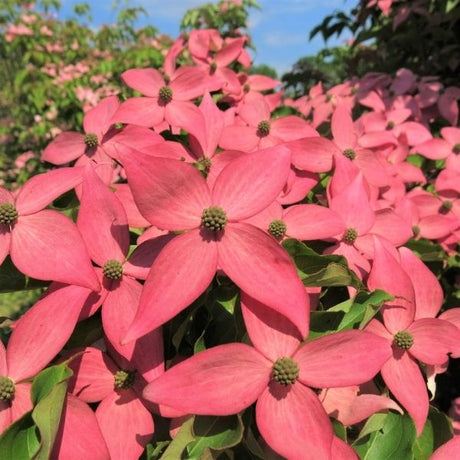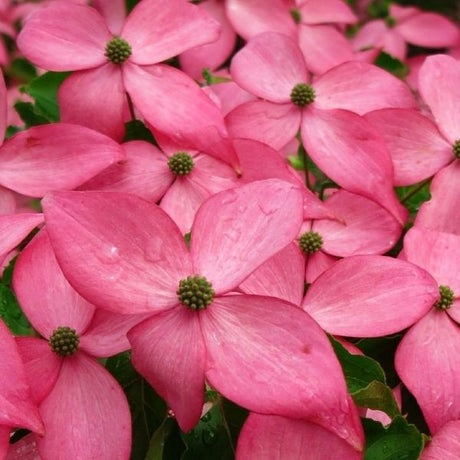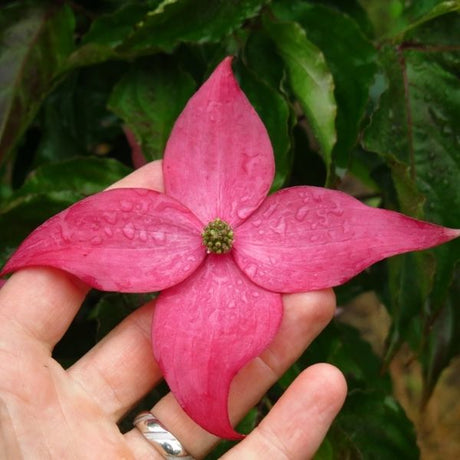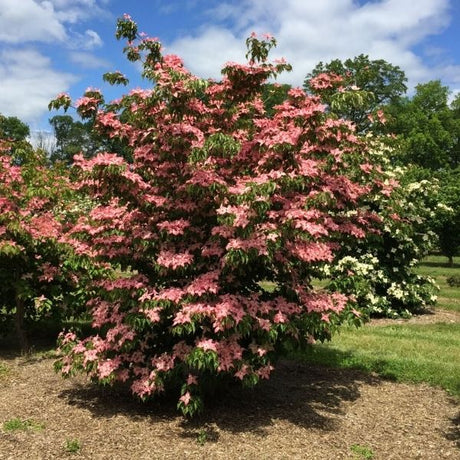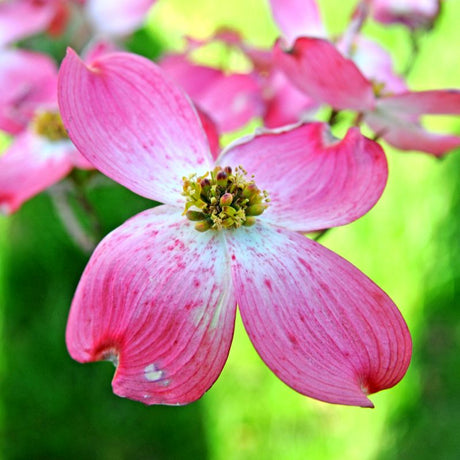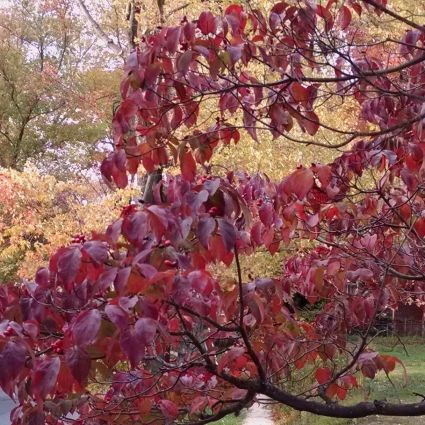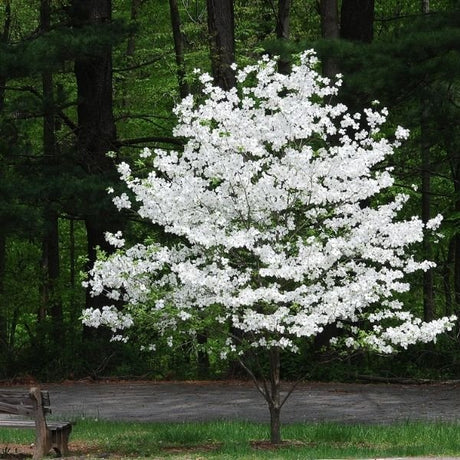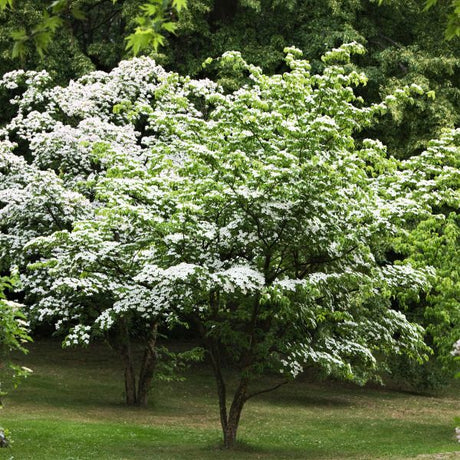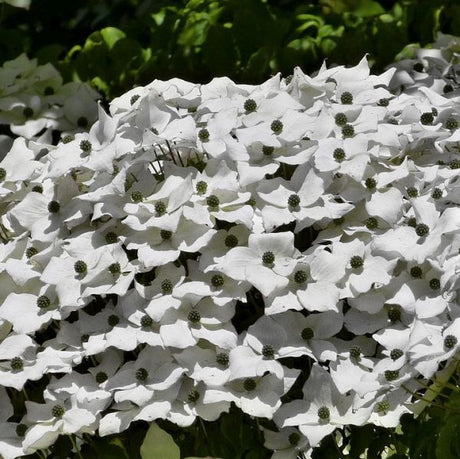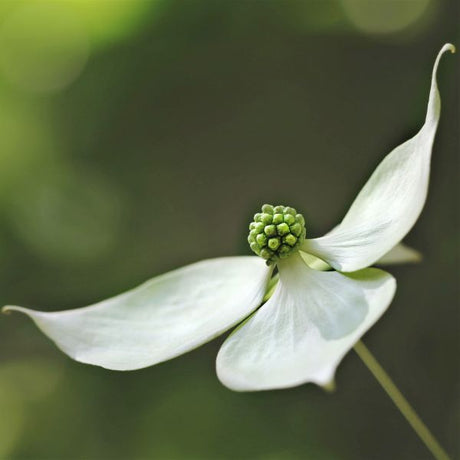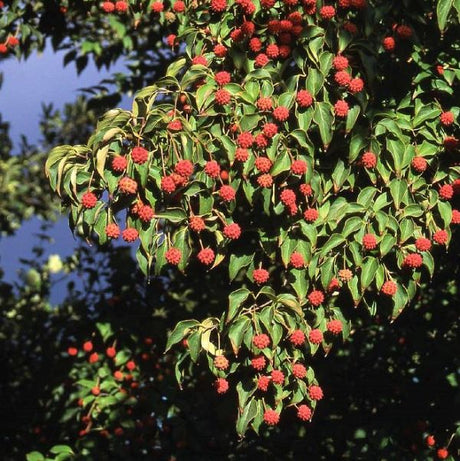-
Up to 12% off
Cornus florida
Sale price From $4988 Regular price $5688Unit price /Unavailable -
Scarlet Fire® Rutgers Japanese Dogwood
Cornus kousa 'Rutpink'
Regular price $8015Unit price /Unavailable -
11% off
Cornus kousa 'Satomi'
Sale price $9854 Regular price $11087Unit price /Unavailable -
11% off
Cornus florida 'Comco No. 1'
Sale price $6990 Regular price $7867Unit price /Unavailable -
29% off
Cherokee Princess Dogwood Tree
Cornus florida 'Cherokee Princess'
Sale price $7130 Regular price $9979Unit price /Unavailable -
Sold out
-
Sold out
-
-
Sold out
Cornus florida f. rubra
Regular price From $7962Unit price /Unavailable -
Sold out
-
Cornus florida 'Cherokee Chief'
Regular price $11493Unit price /Unavailable -
-
Sold out
-
-
Cornus kousa var. chinensis 'JN6'
Regular price $5979Unit price /Unavailable
Flowering Dogwood Trees for Sale at Nature Hills
Looking for the perfect spring-flowering tree? White Dogwood trees and Pink Dogwood trees are among America's most beloved native ornamentals, and you'll find exceptional varieties right here at Nature Hills. Whether you're searching for the classic white blooms of Cherokee Princess or the romantic pink blush of Stellar Pink, our Flowering Dogwood collection delivers four-season beauty to gardens in zones 5-9.

After your Redbud trees leaf out, flowering dogwood trees (Cornus florida) steal the show with their distinctive bracts spanning from pure white to deep red. These moderate-sized trees typically reach 15-30 feet tall with graceful horizontal branches, making them ideal for smaller yards and shade gardens.
Flowering dogwood trees are true four-season performers: Spring brings spectacular blooms before the leaves emerge, summer showcases attractive oval foliage, fall delivers brilliant red to burgundy color, and winter reveals distinctive alligator-textured bark and elegant branching structure.
Popular Flowering Dogwood Varieties
White Flowering Dogwood Trees: The classic choice for traditional landscapes. Cherokee Princess Dogwood offers pristine white blooms and exceptional cold hardiness down to zone 5. This spreading variety develops into a stunning living sculpture as it matures, perfect for creating a focal point near ponds or open lawn areas.
Pink Flowering Dogwood Trees: For romantic, eye-catching color, Stellar Pink Dogwood features soft pink-blushed bracts along its layered branches. This upright variety brings refined elegance to foundation plantings and woodland edges.
Red Flowering Dogwood Trees: Make a bold statement with Ragin' Red Dogwood, which delivers brick-red flowers in spring combined with spectacular mixed fall color. For even deeper tones, Scarlet Fire® Rutgers Dogwood offers fuchsia-pink flowers and burgundy fall foliage with superior disease resistance.

Cherokee Dogwood Series: Disease-Resistant Favorites
The Cherokee series represents some of the most reliable F,lowering Dogwood varieties for home landscapes. These cultivars offer improved disease resistance compared to wild-type dogwoods, addressing one of the primary concerns for Dogwood growers.
Create custom color combinations by grouping different varieties together. Plant darker red dogwood trees in the background with pale white bloomers in the foreground for added depth and visual intrigue. The power of three creates an especially lyrical effect when you group three complementary varieties together.
For smaller spaces, Little Poncho Kousa Dogwood stays compact while delivering impressive white bracts. This four-season selection works beautifully in courtyard gardens and narrow planting beds.
How to Identify Flowering Dogwood Trees
Flowering Dogwood trees are easily recognized by several distinctive features. The bark develops a unique alligator-skin texture with finely-blocked gray patterns along the trunk, creating wonderful winter interest.
The showy "flowers" are actually bracts (modified leaves) surrounding a cluster of tiny true flowers in the center. These bracts can be rounded with a notched tip or pointed, depending on the variety, and they remain attractive for several weeks in spring.
Dogwood leaves are oval-shaped with prominent curved veins radiating from a central midrib, growing about 5 inches long and 2 inches wide. The undersides appear pale green, and fall brings dramatic transformation to red, burgundy, and purple tones.
The button-like cluster of true flowers develops into distinctive raspberry-shaped berries by fall. These bright red fruits add ornamental appeal, though songbirds often harvest them quickly.
Best Growing Conditions for Flowering Dogwood Trees
Dogwood trees perform best with morning sun and afternoon shade. As native understory trees, they naturally thrive beneath the forest canopy. Aim for 4-6 hours of dappled sunlight daily, ideally with morning sun to dry foliage and prevent disease issues.
Hardiness Zones: Most Flowering Dogwood varieties thrive in zones 5-9, though some cultivars like Cherokee Princess tolerate zone 5 winters (Minneapolis-style cold). In northern zones, they'll handle slightly more sun exposure, while southern gardeners should prioritize afternoon shade.
Soil Requirements: Dogwoods prefer moist, well-drained soil with acidic to neutral pH (5.5-7.0). They have shallow root systems, so maintain a 3-inch layer of mulch to retain consistent moisture and regulate soil temperature. Never allow them to sit in standing water.
Spacing: Plant dogwood trees 20-25 feet apart to allow proper air circulation and room for their mature horizontal branching habit. This spacing helps prevent disease issues and showcases each tree's natural, graceful form.
Perfect Companion Plants for Dogwood Trees
Create a stunning shade garden by pairing your Flowering Dogwood trees with complementary understory plants. The dappled shade beneath Dogwood canopies provides ideal conditions for shade-loving companions.
Excellent companion plants include:
- Hostas for bold foliage texture and seasonal blooms
- Ferns for delicate, lacy texture
- Azaleas for coordinated spring color
- Virginia Sweetspire for fragrant summer blooms
- Fothergilla for bottlebrush flowers and brilliant fall color
- Gro-Low Sumac as effective ground cover
Layer spring-flowering bulbs beneath your Dogwoods for early-season interest. Naturalized drifts of Daffodils and Bluebells create a woodland garden effect.
Wildlife Benefits of Dogwood Trees
Beyond their ornamental beauty, flowering Dogwood trees support beneficial wildlife and pollinators. The tiny true flowers attract bees and butterflies, including the spectacular Cecropia Silk Moth, which uses Cornus species as a host plant.
Cornus florida is an important wildlife food source. The bright red fall berries feed over 36 bird species, plus squirrels and other wildlife. Songbirds particularly love the high-fat content of Dogwood fruit, often stripping ripe berries quickly in fall. The Spring Azure butterfly also relies on dogwood as a host plant.
While Flowering Dogwoods offer moderate deer resistance, hungry deer may browse young trees in winter. Protect new plantings with repellents or fencing until they establish.
Common Questions About Flowering Dogwood Trees
Are dogwood trees fast-growing? Flowering Dogwoods have a moderate growth rate, typically adding about 12 inches per year under ideal conditions. While not rapid growers, they establish well and begin blooming within 2-3 years of planting. Start with our largest available containers for immediate impact.
Why won't my dogwood bloom? Several factors affect blooming: insufficient sunlight (they need at least 4 hours daily), improper pruning timing (prune only after flowering), excessive nitrogen fertilizer, or the tree being too young. Established trees bloom reliably each spring.
How do I prevent dogwood diseases? Choose disease-resistant varieties like the Cherokee series or Rutgers hybrids. Provide proper spacing for air circulation, avoid overhead watering (which promotes fungal issues), and maintain the morning sun/afternoon shade pattern to keep foliage dry.
Can I grow flowering dogwoods in containers? Compact varieties like Little Poncho adapt well to large containers (at least 24 inches in diameter). Use quality potting mix, monitor moisture carefully, and provide winter protection in cold climates.
Planting and Care Tips for Dogwood Trees
Best planting time: Plant Dogwood trees in early spring or fall for best establishment. However, container-grown trees can be planted throughout the growing season with proper care. If you find your favorite variety in stock, order immediately. Our inventory moves fast, especially in large sizes.
Planting depth: Never plant Dogwoods too deep. Keep the root flare at the same level it was growing in the nursery container. Planting too deeply is a leading cause of stress and poor performance.
Watering: Keep newly planted Dogwoods consistently moist (but not waterlogged) during their first growing season. Established trees need about 1 inch of water weekly, more during hot, dry periods. The shallow root system requires regular moisture.
Mulching: Maintain a 3-inch layer of organic mulch extending to the drip line, but keep mulch several inches away from the trunk to prevent rot. Dogwoods prefer a naturalized setting with their roots protected.
Pruning: Minimal pruning required. Site your Dogwood where it has room to reach its natural size (15-30 feet depending on variety). If needed, prune immediately after flowering to maintain shape. Dogwoods are slow to heal from cuts, so avoid unnecessary pruning.
Fertilizing: Apply a balanced, slow-release fertilizer in early spring. Avoid high-nitrogen formulas, which promote foliage at the expense of blooms. Include Nature Hills Root Booster at planting for lifelong root system support.
Design Ideas with Flowering Dogwood Trees
Single Dogwood trees create stunning focal points in mulched lawn beds, but groupings deliver even more impact. The power of three creates a lyrical sensation. Plant three complementary varieties in an informal triangle for a custom, high-end look.
Read more about the Power of Three in Garden Design
Create depth by varying bloom colors: place darker red flowering dogwoods in the background with pale white bloomers in the foreground. This technique adds dimension and draws the eye through your landscape.
Ideal locations for dogwood trees:
- Woodland garden edges where they receive dappled morning light
- Near water features or ponds as living sculptures
- Front yard foundation plantings (choose compact varieties)
- Mixed borders with shade-loving shrubs and perennials
- Naturalized areas with native plant companions
The History and Cultural Significance of Dogwood Trees
Native Dogwood (Cornus florida) has a long and cherished history in American landscapes. It's the state tree of Virginia and Missouri, and the state flower of North Carolina, reflecting its importance across the eastern United States.
The native range extends from Maine to Florida and west to Texas, making it well-adapted to a wide variety of climate conditions. Properly sited flowering dogwood trees can live 80+ years, becoming treasured heirloom trees that mark seasons and create memories across generations.
Shop Flowering Dogwood Trees at Nature Hills
Whether you're looking for classic white dogwood trees, romantic pink varieties, or bold red bloomers, Nature Hills offers the finest selection of healthy, nursery-grown flowering dogwood trees. Our expert growers ensure each tree arrives in premium condition, ready to thrive in your landscape.
Find the perfect dogwood tree for your garden at NatureHills.com. Browse our complete collection and place your order today. We'll ship at the optimal planting time for your zone, and every order is backed by our satisfaction guarantee.
FAQ's for Buying Flowering Dogwood Trees Online
When is the best time to plant Flowering Dogwood trees?
When is the best time to plant Flowering Dogwood trees?
The ideal times to plant Flowering Dogwood trees are during spring or fall when temperatures are cooler. If planted in summer, it's important to keep them well-hydrated to help establish strong roots.
Do Flowering Dogwood trees need full sun or partial shade?
Do Flowering Dogwood trees need full sun or partial shade?
Flowering Dogwood trees thrive with morning sun and some afternoon shade, especially in hotter climates. In cooler regions, they can tolerate more direct sunlight when planted with good mulch coverage.
How fast do Flowering Dogwood trees grow?
How fast do Flowering Dogwood trees grow?
Flowering Dogwoods grow at a moderate rate of about 1 foot per year. They reach mature heights between 15 to 30 feet depending on the variety and growing conditions.
Are Flowering Dogwood trees good for wildlife?
Are Flowering Dogwood trees good for wildlife?
Yes, Flowering Dogwood trees are excellent for supporting wildlife. Their spring blooms attract pollinators, and their fall berries feed over 28 species of birds along with small mammals like squirrels.
What are the most popular types of Flowering Dogwood trees?
What are the most popular types of Flowering Dogwood trees?
Popular varieties include Scarlet Fire® Dogwood for vibrant pink blooms, Cherokee Princess for classic white flowers, and Stellar Pink Dogwood for soft pink, disease-resistant beauty in the landscape.


